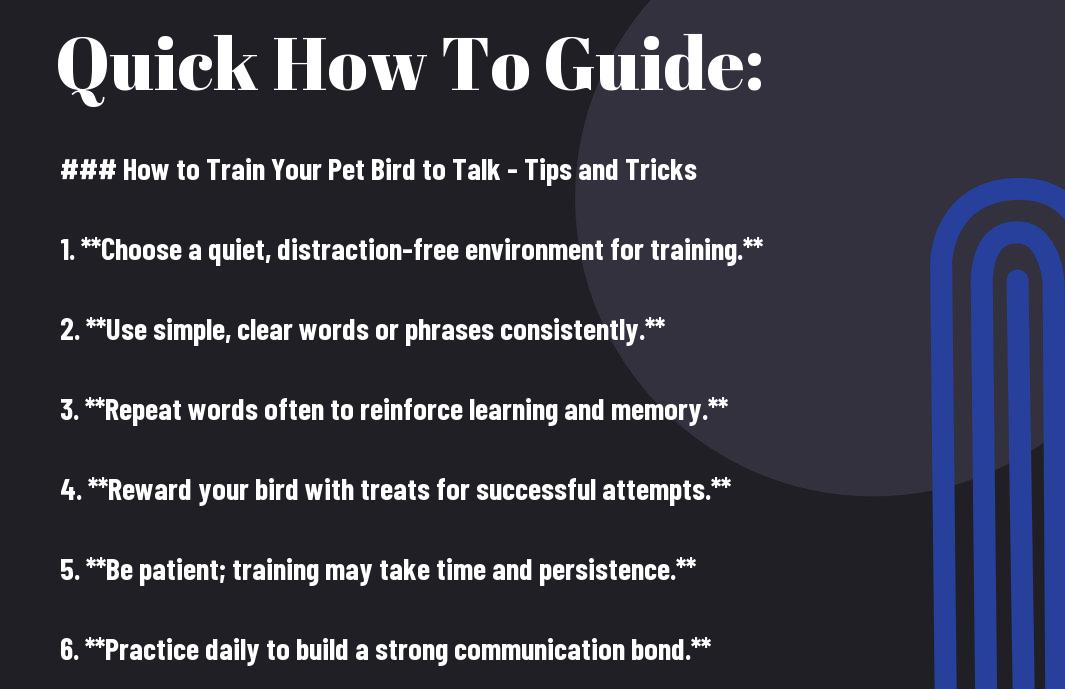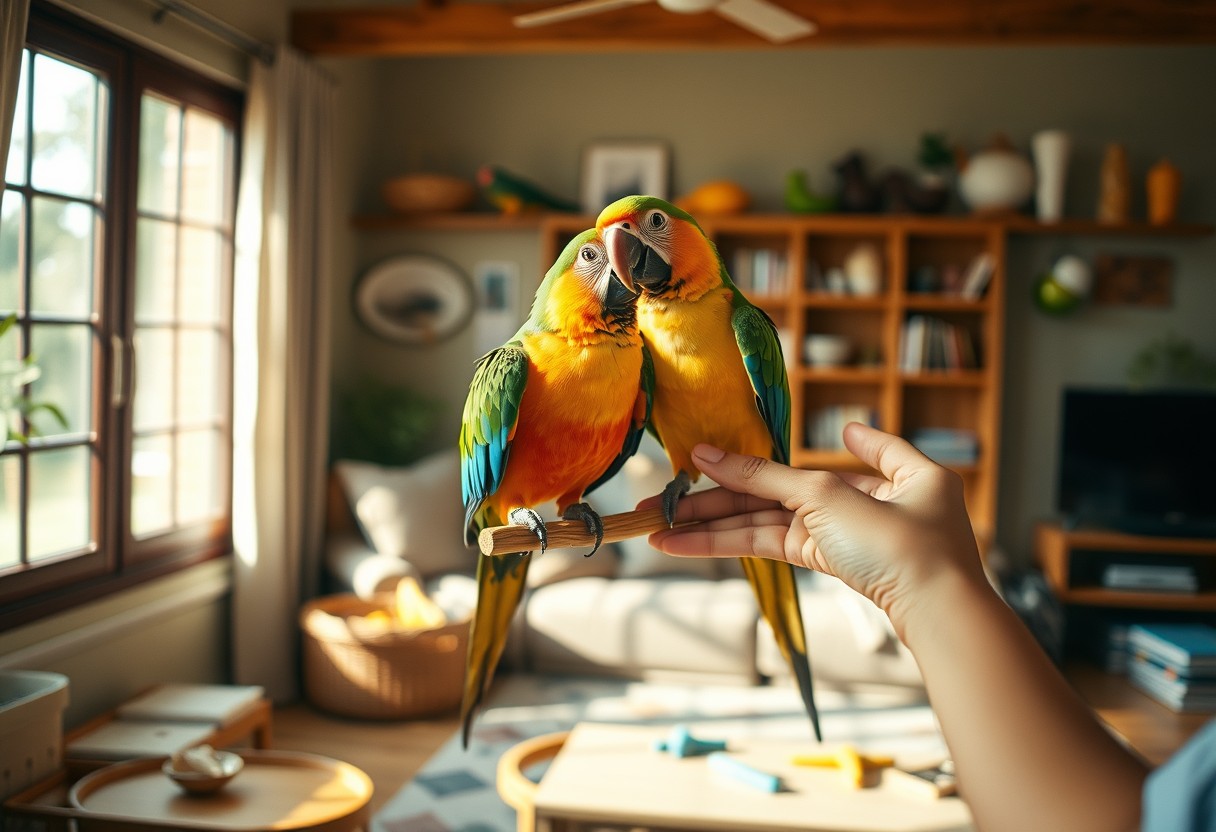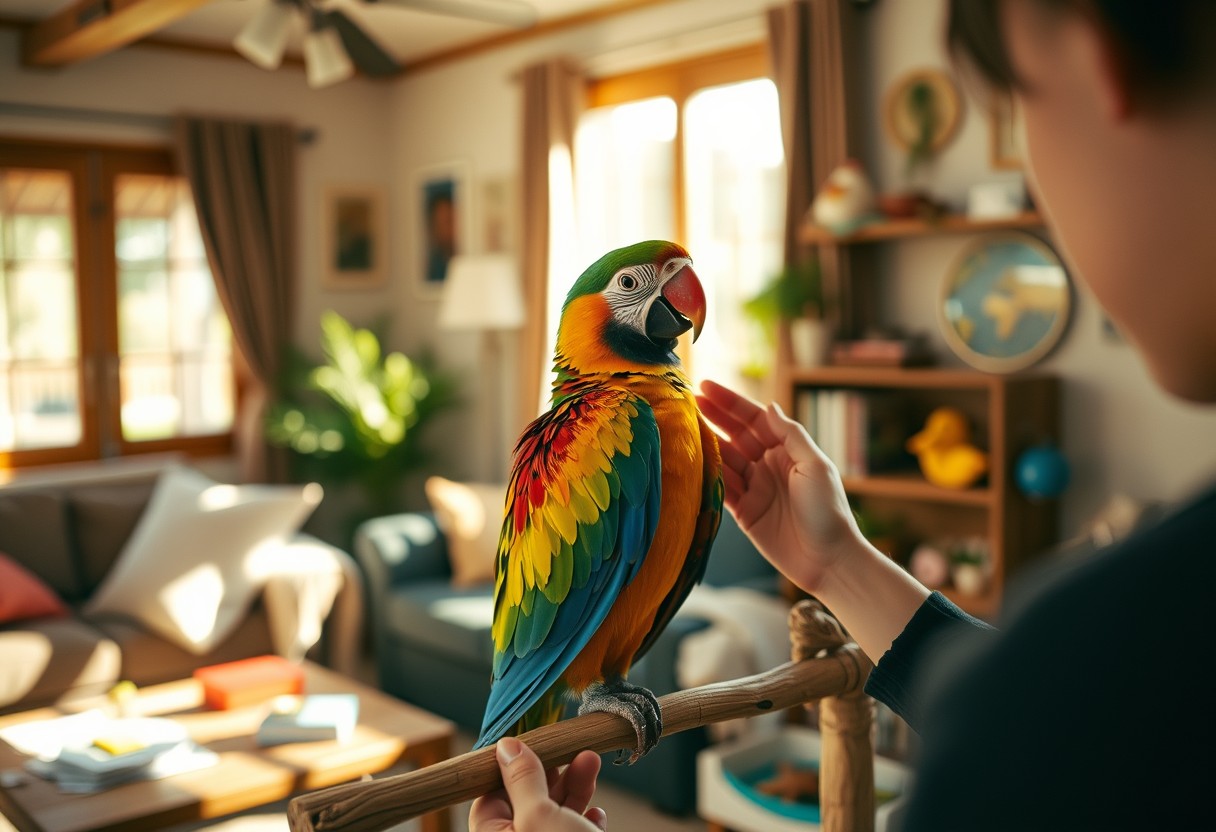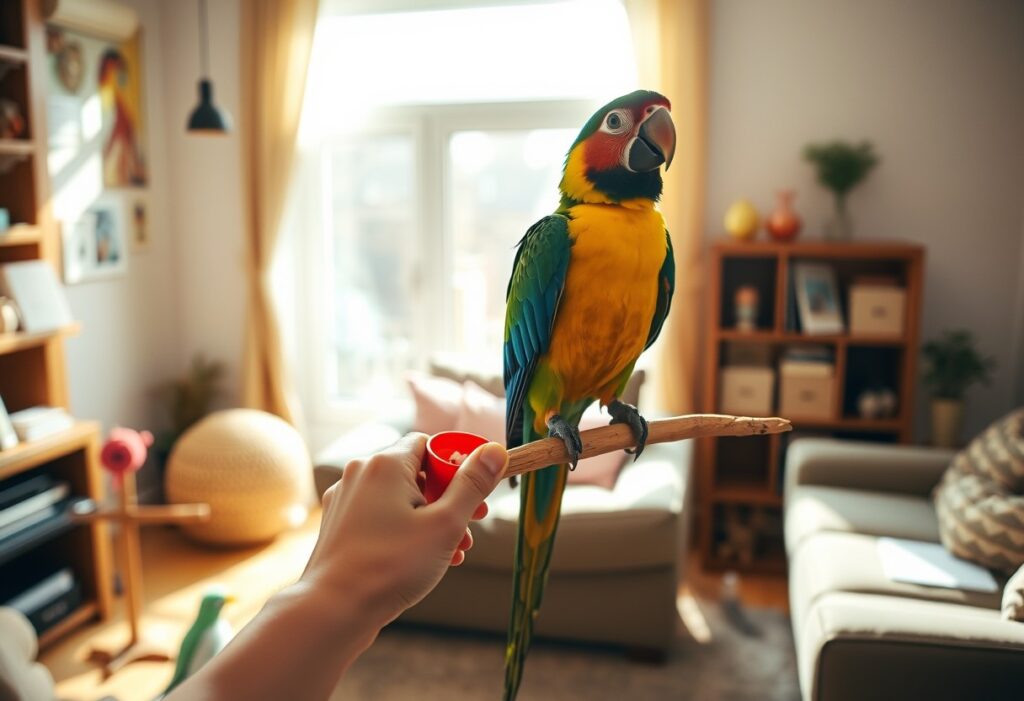Many pet owners dream of having their birds mimic human speech, creating a delightful bond between you and your feathered friend. Training your pet bird to talk not only enhances their social skills but also offers mental stimulation that is crucial for their well-being. In this guide, you will discover effective tips and tricks to make the learning process enjoyable and rewarding. Keep in mind, patience and consistency are key, so prepare to invest your time and love into this positive experience for both of you.

Understanding Your Bird
To effectively train your pet bird to talk, it’s crucial to have a good awareness of its natural behavior and the factors that influence its ability to mimic human speech. Not every bird species is inclined to talk, so understanding your bird’s inherent traits is the first step in your training journey.
Factors Influencing Talking Ability
While all birds have their unique voices and sounds, certain species are more predisposed to talking than others. There are several important factors that can influence your bird’s ability to learn to speak, including:
- Species: Some breeds are known for their exceptional mimicry skills, such as African Grey Parrots, Amazons, and Budgerigars.
- Age: Younger birds typically have a higher capacity to learn new sounds than older ones.
- Socialization: Birds that are exposed to human interaction and communication often tend to develop their talking ability more effectively.
- Environment: A stimulating environment can encourage vocalization and mimicry, so ensure your bird has enough enrichment.
Perceiving these factors can dramatically affect your success rate in training your bird to talk.
Choosing the Right Breed
The choice of bird breed is crucial when it comes to teaching your feathered friend to talk. Some birds have innate characteristics that make them more proficient in mimicking human speech. For instance, African Grey Parrots are renowned for their exceptional intelligence and vocal capabilities, while Budgerigars are popular for their engaging personalities and ability to pick up phrases quickly. On the other hand, birds such as canaries and finches are less likely to mimic human speech and are not ideal if your primary goal is to train a talking bird.
A good strategy is to do your research on the specific breed you are considering adopting, as this will help you manage your expectations and enhance your training efforts. A well-socialized bird from a talking breed often demonstrates a more active interest in learning. Additionally, a bird that has been raised in an enriched environment may exhibit more communicative behavior. Remember to assess the health, temperament, and compatibility of the bird with your lifestyle too, as these are vital for creating a rewarding training experience.

How to Begin Training
The initial phase of training your pet bird is crucial, as it sets the foundation for your bird’s ability to learn and communicate. To be successful, you must establish a consistent training environment and build a trusting relationship with your feathered friend. Birds are intelligent creatures that thrive on routine and positive interactions, so it is important to approach training with patience and a positive attitude.
Establishing a Routine
To create an effective training regimen for your bird, it is beneficial to establish a specific routine that you follow consistently. Birds feel more secure when they know what to expect, and a daily training schedule will help reinforce this sense of stability. Choose a time that works for both you and your bird, ideally when your pet is alert and active, which is usually in the morning after they’ve had their meal.
Additionally, keep the training sessions short and enjoyable, lasting no more than 10-15 minutes at a time. This allows your bird to remain engaged without becoming overwhelmed or bored. Introducing training gradually will help your bird capture the learning experience positively and ensure that your sessions are effective.
Utilizing Positive Reinforcement
Routine is vital for successful bird training, but alongside it, utilizing positive reinforcement is equally important. This method encourages your bird to learn new words and behaviors by rewarding them with treats, praise, or affectionate interactions when they attempt or successfully imitate words and sounds. Birds have an innate desire to please their owners, and by recognizing their efforts with rewards, you build their confidence and eagerness to engage in training.
The idea behind positive reinforcement is straightforward: when your bird learns to associate specific words or behaviors with rewards, they become more inclined to repeat those actions. For example, if your bird successfully mimics a word and you respond with enthusiastic praise or a small treat, they learn that speaking leads to positive outcomes. This not only encourages your bird to repeat the behavior but also strengthens the bond you share, making training sessions feel rewarding for both you and your pet.
Tips for Effective Training
Keep in mind that training your pet bird will require patience, understanding, and commitment, but with the right approach, you can enable your feathered friend to communicate with you. Here are some important tips to ensure successful training:
- Set a calm environment for training.
- Always use positive reinforcement.
- Be patient during your training sessions.
- Stay consistent with your words and phrases.
- Use engaging rewards to motivate your bird.
Any dedicated owner can make significant progress in training their pet bird to talk by following these guidelines.
Short Training Sessions
While it may be tempting to have lengthy training sessions, it is crucial to remember that birds have shorter attention spans compared to other pets. Aim for short, focused sessions lasting around 5 to 10 minutes. This will keep your bird engaged and prevent it from becoming bored or frustrated.
Short training sessions also allow you to gauge your bird’s learning pace and adjust accordingly. By keeping the training brief and enjoyable, your bird will be more likely to look forward to each session and retain what they learn.
Repetition and Consistency
Tips on training your bird effectively include the importance of repetition and consistency. Birds are creatures of habit and learn best when they encounter the same words and phrases repeatedly. Make sure to use the same words consistently during your training to help your bird grasp their meaning.
Incorporating regular practice into your routine will further reinforce learning. You might say “hello” every morning, or use specific phrases when feeding your bird, so the repetition becomes a part of its daily life. This reinforcing method will allow your bird to associate the words with their context, making the learning process smoother.
This persistence will create a solid foundation for your training sessions, fostering an environment where your bird feels comfortable to mimic those words in time.
Using Clear, Simple Words
For effective communication, it’s necessary to utilize clear and simple words when teaching your bird to talk. Start with basic words that are easy for your bird to understand and repeat. Words like “hello,” “goodbye,” or your bird’s name can be great starting points. Focus on ensuring that your bird can clearly hear and associate the sound with the word.
Another helpful tip is to avoid using complex phrases initially, as they can confuse your bird, making learning tougher for both of you. Gradually introduce more complex words and phrases as your bird becomes more comfortable in its learning environment.
It’s crucial that your bird hears the correct pronunciation consistently, as this directly impacts their ability to mimic the words effectively.

Troubleshooting Common Issues
Unlike many pet owners assume, training your bird to talk is not always a straightforward process. Various issues can arise that may hinder your bird’s progress. By recognizing and addressing these common problems, you can help ensure that your feathered friend becomes a confident and vocal companion.
Lack of Motivation
An important factor in training your pet bird to talk is motivation. If your bird is not enthusiastic about speaking, it may simply be uninterested in the process. Determining what truly excites your bird, whether it’s treats, toys, or praise, can help you find the right incentive. Monitor your bird’s behavior closely to identify what engages them the most during training sessions, and incorporate those elements to keep your pet motivated and attentive.
Additionally, consider establishing a consistent training routine. Birds tend to thrive on routine, and having a dedicated time each day for training can create anticipation and eagerness to participate. If all else fails, ensure your bird is healthy, as a lack of motivation could also be a sign of an underlying health issue.
Overcoming Shyness
While some birds may be naturally outgoing, others can be quite shy, making training a challenge. If your bird is hesitant to speak, try to create an environment where your bird feels safe and comfortable. Start speaking softly and close to your bird to build trust. Over time, they may become more relaxed and open to mimicking sounds.
For instance, spending quality time with your bird outside of training sessions is crucial. Engage in gentle activities such as playing, whispering, or simply being present, which can help your bird associate you with positive experiences. Gradually, your bird will begin to warm up to you and may eventually feel more confident in using their voice during training. Be mindful of, patience is key—allow your bird the time it needs to come out of its shell.
Summing up
Hence, training your pet bird to talk can be a rewarding experience that enhances the bond between you and your feathered companion. By implementing consistent speaking sessions, using positive reinforcement, and creating an engaging learning environment, you set the stage for successful communication. Remember to choose simple phrases that are frequently repeated, as this aids in your bird’s ability to mimic sounds and words. Regular practice and patience are vital, ensuring that your bird feels comfortable and motivated throughout the training process.
In addition to these techniques, it’s important to recognize that each bird has its own personality and pace when it comes to learning. Celebrate small victories along the way, and don’t hesitate to adapt your methods if needed, as flexibility can lead to better results. With dedication and a loving approach, you can teach your pet bird to talk, adding an exciting dimension to your shared life. Enjoy the journey of communication, as it opens doors to deeper interactions and a more fulfilling companionship with your avian friend.
Q: What is the best age to start training my pet bird to talk?
A: Ideally, the best age to start training your pet bird is between 3 months to 6 months. Young birds are generally more receptive to learning new sounds and words. However, older birds can also learn to talk, but it may take a little more time and patience. Consistency in practice, positive reinforcement, and creating a stimulating environment can all assist in the learning process, no matter the age of your bird.
Q: How long should I train my bird each day for effective results?
A: Training sessions should be relatively short, typically lasting about 5 to 15 minutes each day. Birds have short attention spans, so it’s vital to keep training sessions engaging and fun. You can conduct multiple short sessions throughout the day instead of one long session. This helps to maintain your bird’s interest and ensures they are mentally stimulated without becoming overwhelmed.
Q: What techniques can I use to encourage my bird to mimic words or phrases?
A: To encourage your bird to mimic words or phrases, use the following techniques:
1. **Repetition**: Consistently repeat words or phrases while interacting with your bird. The more they hear a word, the more likely they are to learn it.
2. **Positive Reinforcement**: Give your bird treats, praise, or affection when they attempt to mimic words. This reinforces their learning and encourages them to try again.
3. **Modeling**: Speak clearly and in a cheerful tone. If your bird sees you enjoying the conversation, they may be more likely to participate. You can also play recordings of other birds talking to provide an auditory example.
4. **Social Interaction**: Engage with your bird while training. Talking to your bird as though you are conversing can spark their interest in learning to talk back.











